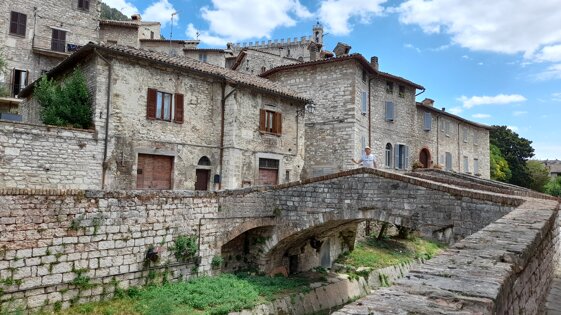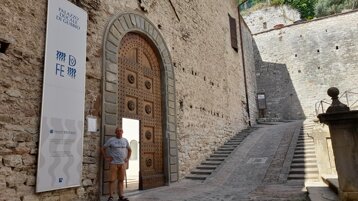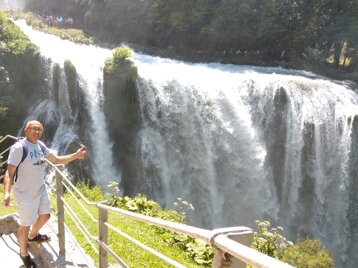© Use of content without authorization is prohibited

Umbria
Perugia Terni
This region is at the center of the Italian peninsula; a small, predominantly hilly territory that holds great treasures. In my wanderings I discovered a land with a green heart where the blue of fresh waters abounds, such as Lake Trasimeno, the Tiber River, and the beautiful Marmore Falls. As a young backpacker I took part in Umbria Jazz, an important music festival, visiting medieval cities like Perugia, Assisi with a climb to the Hermitage of the Carceri, Gubbio, and Spoleto. Umbrian cuisine, very flavorful, gave me the fuel to enjoy long walks surrounded by so much beauty. Among my favorite dishes are Bruschetta, Ciriole alla Ternana, Tagliatelle with Truffle, and, if I want to indulge in a guilty pleasure “once in a while,” Norcia Sausage and Porchetta from Bastia Umbra. As for the wines, I stick to an excellent white suitable for all dishes: Orvieto Classico.

Province of Perugia
Area: 6335.65 km² Population: 638,130 Municipalities: 59
Gubbio: Historic Center
Gubbio: Historic Center
Travel photos...



Gubbio
Gubbio
Gubbio
Archaeological site of the Roman Theatre
The 16th-century Fountain of the Madmen
Doge's Palace

Province of Terni
Area: 2128.31 km² Population: 216,248 Municipalities: 33
Rafting on the Nera river
Rafting on the Nera river
travel stories...



Alviano
Marmore Falls
Terni
In my comings and goings between the north and south of Italy, I have often stopped in Umbria. On a scorching July day, I discovered this village in the Tiber Valley. A road lined with maritime pines leads me to the entrance of the town, climbing gently among the houses until I find myself in front of the imposing Doria Panphili Castle; the manor takes its name from the noble family, its last owner before it passed to the municipality, which made it its town hall. It is a medieval fortress with four bastions and a high surrounding wall with a statue of a lion at the entrance. The Castle of Alviano is perfectly preserved and inside it has important frescoes on the life of St. Francis. There are also two museums: the Museum of Rural Art, and the Museum of Mercenary Captains; the latter in honor of the Captain of the Republic of Venice Bartolomeo D’Alviano, who in the sixteenth century gave the castle its current form. I then visit the parish church dedicated to Santa Maria Assunta, built in the sixteenth century with beautiful frescoes from the Renaissance period inside. A stroll through the historic center and a look from the viewpoint; from here you can overlook the entire valley, in particular the artificial lake formed by the damming of the Tiber and the WWF nature reserve. To conclude, nothing better than a plate of bruschetta, with tomato, olive pâté, with local oil, with truffle.
Arriving late in the evening, I found a decidedly poor hotel. However, the accommodation is in a good location along the Nera river promenade. Early in the morning, I reached the Church of the Sacred Eucharistic Heart, with its facade rich in statues and a rose window surrounded by exposed bricks. I never give up a hearty breakfast; near the church, I found a bar where I enjoyed some good croissants and an orange and lemon juice just the way I like it. I cross the Nera river on the ultra-modern pedestrian bridge dedicated to the architect Malagricci and reach the Lancia di Luce obelisk, a monument of industrial archaeology by the sculptor Arnaldo Pomodoro; from here I head straight to the center where I admire the ancient Church of San Salvatore dating back to medieval times. A little further on, in sequence, I visit Palazzo Spada, now the town hall with the statue of Thyrus, the dragon symbol of Terni; the seventeenth-century Palazzo Montani and Piazza della Repubblica, the city's elegant lounge. From there I continue to Piazza Tacito, a meeting point for young people from Terni; unfortunately, due to restoration work, I cannot admire the fountain up to the station where, in the middle of a large flowerbed, a gigantic steel sculpture called "La Pressa" stands out. It's gotten late, and there's nothing better to end the evening than dining in the romantic center of the city of Saint Valentine.
After passing the industrial outskirts of Terni with the endless steel mill warehouses, I arrive in a few minutes at the convenient parking lots (cost 5 euros) of the "Ex Viscosa" area. Long queue at the ticket office, under a scorching sun; I regret not having bought the ticket online because while I'm there an acoustic signal announces the release of the water. Right after the entrance, there is a booth where a guide tells the story of this artificial waterfall that, from the Velino river, plunges into the Nera river in three drops of 165 meters. A few steps and I am at the Lower Belvedere, one of the most spectacular points where you can see the waterfall in all its grandeur. The first impression is the kind of "I'm where I want to be" that often happens to me in front of a famous monument. Photos in every pose. I have a sandwich at one of the refreshment points inside the park, where I also find typical local products. I continue on a path that takes me right under the waterfall, where the sound of the water gives an idea of the power of nature and, as if by magic, a rainbow forms; I go back down soaked from head to toe, regretting not having bought the raincoat (cost 1 euro). I dry off in the August sun while rafts descend the rushing waters of the Nera river; for them the excitement continues, while for me this exciting adventure ends here.